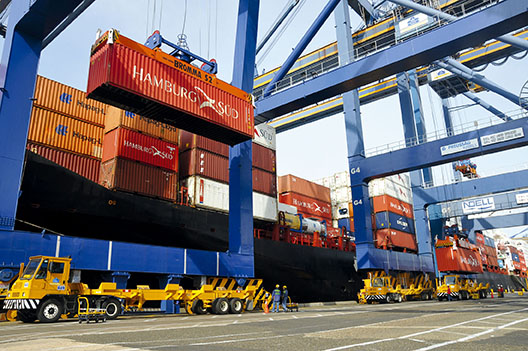New technology – potential to revolutionize port efficiency
... global automated container terminal market expected to grow at impressive 25% by 2021
By Miles J. Varghese *
2017, June 1: Forget driverless vehicles! We could be a mere three years away from seeing robotic cargo ships take to the seas! In today’s digital world, technology has brought forth monumental advances that have improved the efficiency of countless industrial and societal processes. For the maritime sector in particular, the promise of new technologies is already transforming how more than 90% of the world’s seaborne trade is managed.
Just a few decades ago, terminal operations revolved around the resource-intensive task of manually monitoring activities and container movements. Today, we are beginning to see a new reality that relies on technology to optimize operations and increase the rate and accountability of work at ports. As the shipping industry continues to embrace the opportunities that technology presents, terminal automation, digitization and the use of real-time data are quickly becoming the norm.
While there’s no way to accurately predict the magnitude of impact, there are areas in which technology has the potential to revolutionize port efficiency.

Real-time data
Data collection is key for increasing efficiency. Not only is it fundamental for efficient operations, it facilitates smarter decision-making. A study by the Massachusetts Institute of Technology (MIT)1 shows that data-driven organizations perform up to 6% better each year. The collection and analysis of big data has the ability to drive transparency across the industry and provide new means of monetization for various service providers.
Cloud-based software such as the Octopi2 Terminal Operating System (TOS) have the ability to revolutionize how shipping companies incorporate data to improve marine terminal productivity. TOS platforms help executive teams visualize and interpret the large amounts of operational data that are collected on a daily basis, all in real-time. With a reliable TOS, the terminal’s productivity increases; stevedores begin communicating and operating as more of a unit; and, ultimately, ships move faster.
Cargo tracking
Each year approximately 1,679 shipping containers are lost at sea due to various factors. However, the power of real-time data has proven especially beneficial for cargo tracking.
The advantages of being able to track exactly where cargo is at all times can have a significant impact on security and delivery estimates. Collecting detailed information about the movements of a container can help to predict if a container will make it in time, or possibly predict if it will get lost at sea.
A container can also be identified with anomalies, alerting customs to look into that container for a possible security breach. Moreover, with high level security controls, marine port operators can easily manage and track cargo in order to report real-time data to customers. This feature not only improves overall customer service by minimizing complaints, it also frees up time for operators to focus on other matters.
Predictive analytics

In addition to increased efficiency, the collection of big data can also lead to operational cost-savings. Capturing data from equipment sensors makes it possible to design a predictive model for each machine type. For example, the addition of sensors alongside predictive analytics software could identify areas that may require maintenance in advance to prevent delays and increase overall efficiency.These insights not only result in maintenance savings but could also avoid potentially catastrophic machinery failures.
Another example: instead of running out of reefer plugs and having to run around looking for options to add capacity at the last minute, technologies can be utilized to know when the availability of reefer plugs is getting low. Being able to react before a problem occurs in your terminal saves time and resources and, of course, improves dependability.
The Port of Cartagena, Colombia, one of Latin America’s busiest ports, handling 40 million tons of cargo per year, recently teamed up with IBM and Cisco to put these claims to the test. The Port is leveraging the IBM Watson IoT Platform and Cisco’s analytics so as to optimise its 24/7 operations. Eduardo Bustamente, Director of Operations at the Port of Cartagena, said: “With these new capabilities, we gain immediate insight into the health and operations of our more than 47 rubber tire gantries and 180 trucks. As a result, we expect to be more productive in our maintenance processes to help ensure our fleet runs even more efficiently and vessels and cargo are moving smoothly in and out of our port.”
Automation

Beyond real-time data and analytics, there is an increasing number of ports moving towards automated operations in order to boost productivity in ways that were not achievable until now. Among its benefits, automation helps to improve the efficiency of cargo transport by reducing errors and speeding up movement both on the front-end and back-end of port operations.
When it comes to improved processes, we have seen data entry time go from 24 hours to one minute. And the risk of error is close to zero because the process is automated. From a sustainability standpoint, automation can also support efforts to reduce fuel costs and emissions, while improving overall safety. Whether robotic cargo handlers unloading containers; or, automated billing systems streamlining office operations, the scope of technological tools available to operators continues to expand.
According to a recent study by the technology advisory firm, Technavio, the global automated container terminal market is expected to grow at an impressive 25% (compound annual growth rate) during 2017 to 2021 and ports are reaping the benefits.
Since transitioning to fully automated processes, the Port of Rotterdam in the Netherlands has significantly improved efficiency with reported production increases of 80%. Over the next decade, the ports of Los Angeles and Long Beach are expected to lead the way in automation in the USA, primarily in response to arrival of more megaships. As ships continue to get bigger, questions arise as to whether operators are maximizing the financial benefit from this trend, particularly if a terminal’s productivity does not increase accordingly.
The next step
Technology does not progress on a linear scale. It happens exponentially. And the shipping industry is moving along with it.
From big data to automation, the quantity and quality of new technologies will continue to evolve. For port operators to remain competitive in the digital age, investing in smart technology should be a top priority in order to boost productivity. In terms of future adoption, it appears to be more a question of when, not if, they will jump on board. []
1 Strength in Numbers: How does data-driven decision-making affect firm performance?
2 Octopi is a Miami-based tech company and innovator in port terminal operations.

* Miles J. Varghese is a Sales Executive at Octopi.





